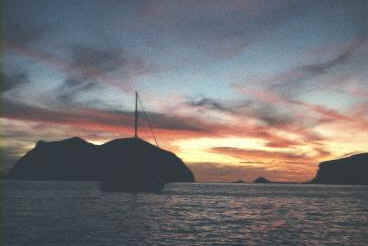| From San Diego we sailed offshore to Isla Guadeloupe in company with friends Matt and Debbie on AEVENTYR, a Seattle-based boat. As we sailed by the Coronado Islands, Mexican island about 25 miles south of San Diego, we caught a 10 lb. yellowfin tuna and had enough fish for 4 meals. This was the first fish caught in Mexican waters, and after paying US$184 for fishing licenses, the four meals cost US$26 each. We hope to catch more fish and bring the meal costs down! | |
| Isla Guadeloupe is a Mexican island about 140
miles off the coast of Baja California, about 235 miles from San Diego, and is a barren
volcanic rocky island populated by about 30 fishermen and a small Mexican naval
detachment. We arrived at the north end of the island around midnight, earlier than we had
expected due to a strong current which gave us an average speed of about seven knots.
Rather than trying to anchor in the dark at the northern bay, we decided to slowly drift
overnight 20 miles along the coast to the southern anchorage. The purpose of this visit was to obtain a supply of lobster (langousta - spiny lobster not the Atlantic variety). We traded food items such as soda pop, chocolate bars, apples and canned foods for the lobster. After a day in a fairly exposed anchorage, and with twelve lobsters in the freezer, we left for a 3 day passage, 400 miles, back to the Baja peninsula. |
|
| Isla Guadeloupe is volcanic and is a colourful lump of rock. There is very little vegetation visible from the sea, however, once ashore, small gray shrubs and many different lichen cover the sharp rock. | |
 |
The ocean sailing was rather extraordinary with average speeds of 6 to 6.5 knots over several 24 hour periods. We had strong winds and large seas during the first night of the return trip. Other sailors we spoke to by radio called it a gale (35 knots of wind) but not having a wind speed indicator (anemometer) we did not know the actual strength of the wind. However, being conservative sailors we had a double reef in the main and with the wind on our starboard quarter (meaning that it came from behind us) we were relatively comfortable and not in any danger. The seas were high, maybe 12 to 15 foot swells also from behind us. We surfed down the large swells and the knot meter showed a maximum of 10.5 knots, with an average of almost 7 knots. As we approached Bahia Santa Maria the wind died completely and we motored for the last 6 hours of the passage. We had arrived in Mexico proper. The Baja to La Paz Journal |
